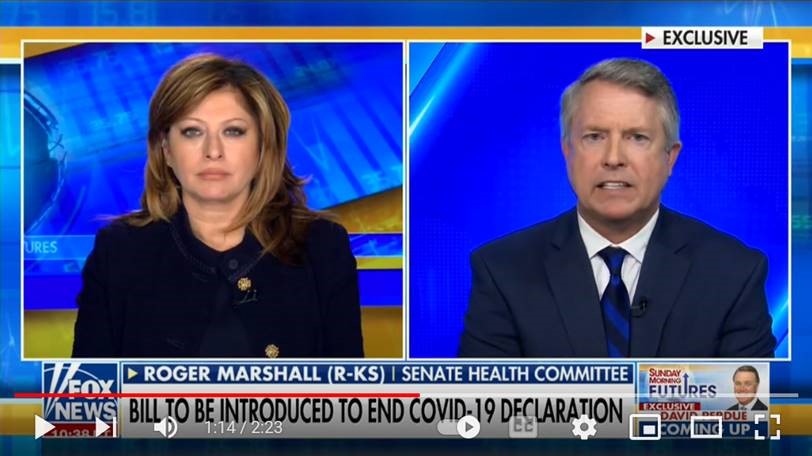- February 15, 2022
Sen. Marshall Resolution Puts an End to COVID State of Emergency
(Washington, D.C., February 15, 2022) – U.S. Senator Roger Marshall, M.D. has introduced a Senate resolution to end the COVID-19 national state of emergency currently in effect under the National Emergencies Act (NEA), which allows the President to make available robust powers to deal with crises other than war or natural disaster. In March 2020, President Donald Trump invoked the NEA in regard to COVID-19 and in February 2021, President Joe Biden extended it until March 1, 2022. Under the NEA, Congress is mandated to determine whether the emergency should continue, a process Congress has not fully enforced, ceding power to the executive. Following introduction of the resolution, Senator Marshall issued this statement:
“With COVID cases and hospitalizations on the decline, 94 percent of Americans having immunity to COVID, mask mandates falling by the wayside, and 70 percent of Americans agreeing ‘it’s time we accept that COVID is here to stay’ and that ‘we just need to get on with our lives,’ it’s clear we need new approach to COVID as we learn to live with it. That new approach starts with putting an end to the COVID national state of emergency,” said Senator Marshall.
Senator Marshall was recently on FOX News’ Sunday Morning Futures to preview legislation. You may click HERE or on the image below to watch his interview about it.
You may click HERE to view the resolution. So far, Senators Mike Braun (IN), Mike Lee (UT), Ron Johnson (WI), Ted Cruz (TX), and Rand Paul (KY) are cosponsors of Senator Marshall’s resolution.
Senator Marshall recently wrote an op-ed for the Daily Caller highlighting the fact that the White House, CDC, and media need to wean themselves off their fixation with COVID, which has caused the American people to live in fear. In the op-ed the Senator offered a path forward post Omicron. You may click HERE to read the Senator’s op-ed in its entirety.
Background:
A provision in the NEA grants Congress termination review of national emergencies, stating that after six months, and every six months after the emergency continues, “each House of Congress shall meet to consider a vote on a joint resolution to determine whether the emergency shall be terminated.” However, Congressional interpretation of this law has determined that the absence of a resolution introduced by any member signals unanimous consent for continuation. In failing to meet, debate, and vote on an emergency, Congress is effectively ceding more unchecked emergency powers to the executive similar to its failure to enforce War Powers provisions.
The NEA outlines an expedited parliamentarian procedure for emergency termination resolutions. Once the resolution is introduced and approved by the parliamentarian, it is referred to the Committee of jurisdiction, likely Senate Health, Education, Labor, and Pensions (HELP) in this instance. The committee of referral is to report one joint resolution along with its recommendations within 15 calendar days after the day of referral, unless the chamber “shall otherwise determine by the yeas and nays.” Once reported, the terminating resolution “shall become the pending business” of the chamber and a vote on final passage is to occur within three calendar days thereafter (unless the chamber “shall otherwise determine by yeas and nays”). After passage in the first chamber, the termination resolution is transmitted to the other chamber and is subject to the same process (15 calendar days for the second-chamber committee to report and then 3 calendar days for a floor vote on final passage).
There are currently 31 national emergencies in effect dating back to the Carter Administration, highlighting the failure of Congress to consider termination of emergencies declared by the President. Only six termination resolutions have been submitted over the history of the NEA. Both the House and the Senate have typically chosen to structure consideration of such measures through other parliamentary means (primarily through adoption of a special rule reported by the Rules Committee in the House and a unanimous consent agreement in the Senate) rather than relying on the statutory procedures described above. These alternative modes of consideration lend greater flexibility to both chambers and arguably provide greater procedural clarity than the procedures laid out under the NEA.
The NEA does not assign specific powers but allows the executive to call up powers outlined in other statutes. Among the actions taken by the federal government under the national emergency declaration are:
- Activation of the Ready Reserve
- Coast Guard officer retiree activation
- Coast Guard enlistee retiree activation
- Coast Guard enlistee extension
- Deferral of Coast Guard end-strength limitation
- Extension of customs deadlines
- Closure of land and ferry crossings along the U.S. northern and southern borders
- Suspension of student loan payments and interest on certain federal loans
###

